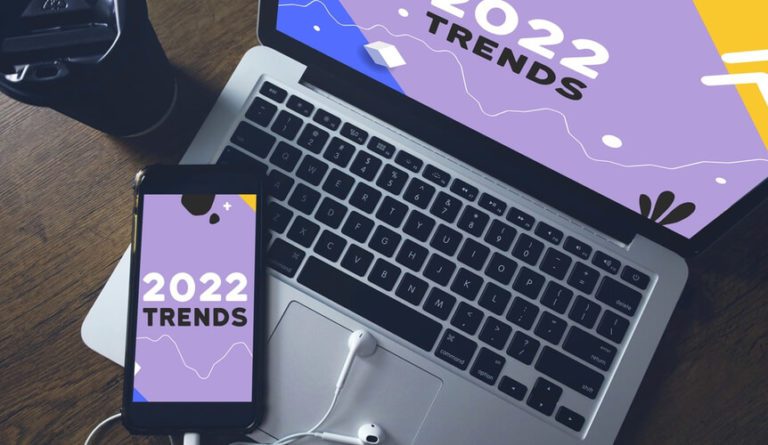It’s time to say goodbye to a year where the phrase “business as usual” was used by no business owner anywhere! It’s time to look forward to the digital marketing trends and innovations that we predict will be driving results for digital marketing campaigns in 2022.
So, here goes…
AI (Artificial Intelligence) will be at the heart of digital
Whereas machine learning is where a computer teaches itself how to do something, AI is where the computer can be as smart as a human being – at least from the point of view of acquiring knowledge and building on what it knows to make new connections.
Google uses a machine-learning artificial intelligence (AI) system called RankBrain to help sort through its search results. RankBrain is part of Google’s overall search “algorithm” and therefore affects how web pages are ranked in the search results (SERPs).
Voice search will continue to affect search queries
Our SEO Team have mentioned this a lot over the past year – and the trend continues to impact search queries.
We can thank innovations such as Google Assistant, Apple’s Siri, and Amazon’s Alexa for just how far voice search technology has come. Its rise in popularity has meant that SEOs now have to consider not only what a user will type into Google when they search, but also what they will ask – which is usually somewhat different.
Optimising for voice search means a greater use of long tail keywords (usually reserved for blogs, articles and FAQs), remembering that when people type they usually use abbreviations (and don’t when they speak). If you think about how you would search for something by typing it online versus saying the search term out loud, all becomes clear – give it a try.
Websites MUST be mobile friendly
Since 2019 Google has indexed web pages mobile-first. This means the search engine looks primarily at the mobile version of a website, considering it to be the ‘primary’ version instead of the desktop version.
This change makes sense, given that it’s anticipated that nearly 73% of internet users will access the internet solely via mobile devices by 2025.
This means that your website has two different ranking positions for mobile and desktop (with different search volumes) – and this will continue to be the case in 2022. If your users predominantly search for your products and services via mobile, then these are your most important rankings.
Creating content – think EAT!
Google keeps repeating that content quality is critical for ranking success. But what does ‘quality’ mean to Google? The EAT principle explains this:
- Expertise
- Authoritativeness
- Trustworthiness
There are a few ways to ensure quality content. First, create buyer personas, which let you understand what kind of content your clients value. Second, conduct search intent research in order to map out the ideal consumer journey. Lastly, harness this information to develop content that fits the format that your users prefer (text, images, video, infographics).
Video content will lead the way
Video content produced for your website will be much more popular on social media channels, so use it to engage your audience. Not only can video content be optimised for search, it will continue to be a leading light across all social media platforms.
Traditionally many small businesses have shied away from video content as it can be expensive to produce. However as marketing investments go, it is extremely worthwhile as it is projected to surpass all other content forms in terms of consumption in 2022.
Image search stand out becomes critical
Image search has changed drastically over the years. In the past, people used image search just to find their favourite photos. However these days they are seeking products, brands, gifs, memes and more.
Google has always required digital marketers to optimise and tag images correctly, and has placed a higher importance on original photography and graphics. For SEOs this can be a quick win on a website – and provides an additional ‘bite of the cherry’ when it comes to appearance in the image search results.
More choice of ad formats than you can shake a stick at!
In a world in which user privacy is a hot topic, all of the major digital platforms have continued to innovate with new ad formats and ways of targeting their users.
Social Media platforms such as LinkedIn, Facebook, Instagram, Twitter, Tik Tok and Pinterest have all introduced smarter, more sophisticated media planning, buying and execution tools in order to appeal to businesses of all sizes.
Google and Bing continue to innovate and have developed automated ad buying processes and tools which assist even the smallest business as they create their own ads to promote their products and services.
I believe they are trying to attract more small businesses into the ad buying marketplace – without the need for experts like us! Whilst I am all for self service, all of the platforms require a certain level of skill and understanding as to how to use them successfully – which is why they all have certification programmes for marketing professionals. It is very easy to waste valuable budgets on ad buying platforms, and this is probably the biggest reason any advertiser turns to an agency to manage their campaigns.
That said, it would seem that the organic algorithms are stacked against businesses who fail to use any ad formats at all – and that seems to apply from Google (surely not!) to all social media platforms. So whether you are considering self service or a digital agency, make sure you have allocated your advertising budget for the year for all of the platforms you wish to use.
